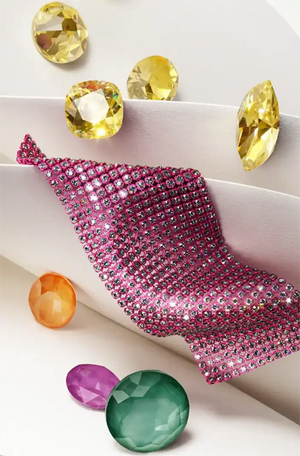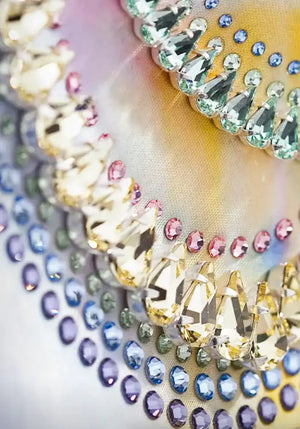
How To Repair A Broken Necklace
Necklaces are timeless pieces of jewellery, perfect for adding a touch of elegance and sophistication to both a daytime or a nighttime look. However, necklaces can also be delicate and fragile, and when they break, it can be disheartening and frustrating - especially if they hold sentimental value.
The good news is that with some patience, a little knowledge, and the right tools, you can repair a broken necklace and return it to like-new condition in just a few steps. In this comprehensive blog post, we’re going to guide you through the process of how to repair a broken necklace, from assessing the damage to completing the repair, so that your treasured accessory can be worn once again with pride. Let’s get started!
Reviving Broken Chains: A Step-by-Step Guide
So, how to fix a broken chain? Here’s what we recommend:
Assess the damage
Before attempting any repair, take a close look at your broken chain to understand the extent of the damage. Is it a simple snap, or are multiple links affected? This assessment will help you determine whether you can handle the repair yourself or if it's best to consult a professional jeweller for a necklace chain repair.
Gather the necessary tools
To repair a broken chain, you may need some or all of the following tools:
- Pliers (both round nose and flat nose)
- Wire cutters
- Jewellery findings (for example, to replace a broken clasp or chain part)
- Jump rings (matching the size and metal of your chain)
- A bead mat or soft cloth
We’d recommend investing in good-quality tools, as this will make your repair work more precise and ensure the longevity of your chain once repaired.
Prepare your workspace
Lay your broken chain on a bead mat or soft cloth to protect the surface and keep the chain from slipping. Make sure your workspace is well-lit and comfortable, as you may need to spend some time working on the repair.
Repair the chain
Follow these steps to repair a snapped chain: Using wire cutters, trim any jagged edges from the broken ends of the chain. Open a jump ring by grasping it with your round nose pliers on one side and your flat nose pliers on the other side. Gently twist the pliers in opposite directions to open the jump ring. Then, thread the open jump ring through the last link on one end of the broken chain.
Connect the other end of the broken chain to the jump ring
Close the jump ring by twisting the pliers in the opposite direction to how you opened it. Ensure that the jump ring is closed securely and that there are no gaps.
Inspect the repair
Once you have completed the repair, inspect the chain to ensure that the jump ring is securely closed and the chain is properly connected. Test the chain by gently pulling on it to make sure the repair has been a success.
How To Repair A Broken Necklace With Preciosa Beads
We receive frequent commissions at our Bluestreak Crystal Studio and sometimes we receive items that need repairing. A recent item in need of such care was a long beaded necklace, which had been loved for so long that the thread became worn out and snapped. As part of the repair, we had to rethread the Preciosa Beads, creating a whole new necklace and in this short guide we will take you through each step of our repair process.
When the necklace arrived, we found that the owner had taken the time to carefully tape together the two ends where the thread had snapped. They had also managed to include a few beads that had been saved from the accident and had kept them with the rest of the necklace for rethreading. If you have a broken necklace and have lost several beads, fear not! We have an exceptional range of colours and sizes in Preciosa Beads and Rondelles on our website, which can replace the missing beads, so that no one will ever know it was ever broken.
For this repair we chose the Griffin Silk for jewellery making, this 100% natural silk can be found on our website in sizes 4, 6 and 8. This thread has a wire at one end, meaning you do not need to worry about separate needles because it is already perfect for threading, you can cut this wire to your preferred length with scissors. When working with loose beads in jewellery making it really helps if your work surface has a texture that will prevent the beads from rolling around. We recommend our Non-Slip Bead Mat, which also has a handy size guide for cutting threads and measuring bead sizes easily.
The rethreading technique:
- With the beads still on the old necklace, pinch a few of them between your thumb and forefinger and bring them close to the end of the thread.
- Push the thin wire of the Griffin silk thread through the bead holes to feed them onto the new necklace a few beads at a time. This may sound complicated, but the wire is so thin that it is surprisingly easy once you have done it one or two times.
- When all the Preciosa beads have been rethreaded, you can cut off the wire because it has now done its job and is no longer needed.
- Tie a tight double knot, try to avoid any slack and conceal the knot under a bead to finish.
The video tutorial for this necklace repair can be found on our YouTube channel, if you found this useful don’t forget to like and subscribe so you can stay up to date with our latest content!
How to take care of necklaces and chains
Proper care and maintenance of your necklaces can help prevent damage and prolong their lifespan, so here are some tips for taking care of your delicate jewellery pieces:
Store your necklaces properly
Store your necklaces separately in a jewellery box or pouch to prevent them from tangling or scratching each other. Hanging them on a necklace stand or hook can also keep them tangle-free and in good condition.
Clean your necklaces regularly
Clean your necklaces gently with a soft, lint-free cloth to remove any dirt, oils, or fingerprints. For more thorough cleaning, use a mild soap and water solution, then dry the necklace thoroughly with a clean cloth. Avoid using harsh chemicals or abrasive materials, as they can damage your jewellery.
Avoid exposing your necklaces to harsh chemicals
Remove your necklaces before swimming, showering, or engaging in any activities that may expose them to chemicals, excessive sweat, or rough conditions. These can weaken or damage the chain over time.
Inspect your necklaces periodically
Regularly inspect your necklaces for signs of wear, such as loose clasps, worn links, or the first signs of damage to the chain; addressing these issues early on can help prevent more severe damage and ensure the longevity of your necklaces. And don’t forget that you can always enlist the help of a professional jeweller if you’re not sure you’ll be able to perform the repair yourself.







